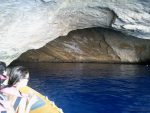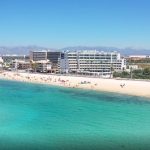Table of Contents
Cabrera has around 17 islands with a total of 13 square kilometres of landscape, which can be reached after about a one hour boat trip from Majorca. Cabrera is a protected ecosystem for marine birds, plants and beautiful seabed’s.
The reserve has approximately 1,318 hectares of surface land and 8,703 hectares of the seabed, with a maximum sea depth of 118 meters.
Get exclusive online discounts on all kinds of Majorca trips & activities
Cabrera History
On the main island, there is a 14th-century castle, which is declared a Balearic historic and artistic monument. Built for protecting both Cabrera and Majorca from Barbary Pirates, fire signals were lit to warn of their arrival.
As pirates became less prevalent in the area, more interest was placed on farming, but after the Battle of Bailen in 1809, Cabrera was offered as a prison for French prisoners of war where they were held for 5 years.
During the 19th Century, the Feliu family tried to repopulate Cabrera by cultivating wine, but in 1916 the area was expropriated for Spanish national defence interest and a 30 man garrison was installed to control the island.
Cabrera has been a National Maritime Park since 1991 and it was also included on the Network of Special Protected Areas for Birds as it is a migratory stop for over 150 bird species, and has over 200 fish species endemic to its seabed’s.
Cabrera Museum & Reserve
At the ethnological museum, the ways of life of the different cultures which have lived in Cabrera can be enjoyed.
Only traditional fishing by local fishermen is allowed in the area in order to protect the wealth of marine life.
Getting There
To visit the Cabrera National Park there is two options: paying for an organised excursion setting off from Colonia de Sant Jordi or Porto Petro, where booking in advance is recommended, or via a private boat for which some requirements must be fulfilled:
- An authorisation is mandatory (phone number – 971-725-010 / 971-725-585). To obtain it you must give information about the boat, owner, and captain. With this permit, you’ll be allowed to sail in Cabrera, but not to stay overnight, get off the boat (into land), or deep sea dive. A maximum of 50 boats are allowed inside the bay of Cabrera at any one time.
- A permit is needed to stay overnight in Cabrera and is limited to 1 to 7 nights depending on the season.
- You also need a permit from the military to set foot on Cabrera.
- To deep sea dive, a permit is also needed, for which it is mandatory to have an advanced divers license, insurance and be aware of the areas that you are authorised areas to dive depending on the time of year.
There are a couple of possible ways to visit the island:
- Guided tours (booked in advance) – Walking trips to Bellamirada, Cala Ganduf, Ses Sitges, la Serra de ses Figueres, el Faro de Ensiola, and the Puig de Picamosques. There is also some routes to be done by kayak or snorkelling.
- Self-guided routes – walk around the bay of the port, from the port to S’Espalmador passing through the military area and the beach, walk up to the Castle (takes about 15 minutes to walk uphill), visit the archaeological findings of Pla de ses Figueres, visit to the ethnologic museum and the botanical gardens, and the longer excursion to the Ensiola Lighthouse.
Cabrera Rules & Regulations
Once in Cabrera there are some basic rules to obey:
- Do not walk off the paths, as you could be stepping on protected plants.
- Hunting and fishing is not allowed
- Do not leave rubbish on the island; take it back with you to Majorca.
- Do not pick up flowers, plants, rocks, seashells, …
- Do not make fires.
- Smoking is only allowed at the port of Cabrera or on the beaches; always make sure that the ends are packed away and not left in Cabrera.
Click to show map!

Mark Kaye is a travel writer and content creator living in Majorca, Spain. Originally from the UK, Mark moved to the island and quickly fell in love with Majorcan culture, food, and scenic landscapes. When he’s not busy writing detailed guides about Majorca’s top tourist attractions and hidden local gems, you can find him out exploring coastal trails or wandering the streets of Palma’s Old Town in search of his next great restaurant discovery.














